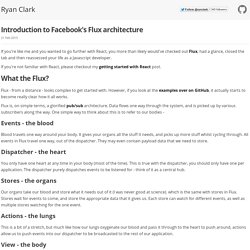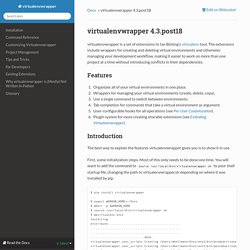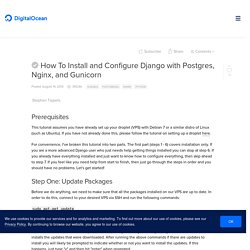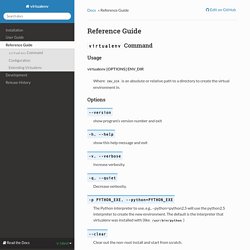

Ressources Création site internet. Introduction to Facebook's Flux architecture. If you're like me and you wanted to go further with React, you more than likely would've checked out Flux, had a glance, closed the tab and then reassessed your life as a Javascript developer.

If you're not familiar with React, please checkout my getting started with React post. What the Flux? Flux - from a distance - looks complex to get started with. However, if you look at the examples over on GitHub, it actually starts to become really clear how it all works. Flux is, on simple terms, a glorified pub/sub architecture. Events - the blood Blood travels one way around your body.
Dispatcher - the heart You only have one heart at any time in your body (most of the time). Stores - the organs Our organs take our blood and store what it needs out of it (I was never good at science). which is the same with stores in Flux. Actions - the lungs View - the body Once our organs have got all that they need from the blood, they can then do stuff with it. Let's chat Install npm install && bower install gulp. Virtualenvwrapper 4.3.post18 — virtualenvwrapper 4.3.post18 documentation.
Virtualenvwrapper is a set of extensions to Ian Bicking’s virtualenv tool.

The extensions include wrappers for creating and deleting virtual environments and otherwise managing your development workflow, making it easier to work on more than one project at a time without introducing conflicts in their dependencies. Features¶ Organizes all of your virtual environments in one place.Wrappers for managing your virtual environments (create, delete, copy).Use a single command to switch between environments.Tab completion for commands that take a virtual environment as argument.User-configurable hooks for all operations (see Per-User Customization).Plugin system for more creating sharable extensions (see Extending Virtualenvwrapper). Introduction¶ The best way to explain the features virtualenvwrapper gives you is to show it in use. First, some initialization steps. Now we can install some software into the environment. We can see the new package with lssitepackages: Support¶ Shell Aliases¶
How To Install and Configure Django with Postgres, Nginx, and Gunicorn. Prerequisites This tutorial assumes you have already set up your droplet (VPS) with Debian 7 or a similar distro of Linux (such as Ubuntu).

If you have not already done this, please follow the tutorial on setting up a droplet here. For convenience, I've broken this tutorial into two parts. Git alias pour être plus productif – Exemples astuces git alias. Fonts. Virtualenv. Adding Compass to your project. By Brandon Rhodes • Home The Compass CSS authoring framework has become one of the standard tools that gets installed when I start working on a new web application.

I always version-control not only the .scss Sass source files that I myself write, but also the .css CSS files that Compass compiles from them. That way, anyone who checks out the project immediately gets a working web site without having to install Compass — or even having to know that it exists, if they are not themselves involved in writing the CSS. But those of us who work on the CSS do need Compass, so I have a standard technique that I copy from project to project that installs Compass into a small, local Ruby environment, providing the same kind of isolation and reproducibility that Python has taught me to know and love thanks to virtualenv. Reference Guide — virtualenv 12.0.7 documentation.
Creating Your Own Bootstrap Scripts¶ While this creates an environment, it doesn’t put anything into the environment.

Developers may find it useful to distribute a script that sets up a particular environment, for example a script that installs a particular web application. To create a script like this, call virtualenv.create_bootstrap_script(), and write the result to your new bootstrapping script. create_bootstrap_script(extra_text)¶ Creates a bootstrap script from extra_text, which is like this script but with extend_parser, adjust_options, and after_install hooks. This returns a string that (written to disk of course) can be used as a bootstrap script with your own customizations.
If you include these functions, they will be called: extend_parser(optparse_parser)¶ You can add or remove options from the parser here. adjust_options(options, args)¶ You can change options here, or change the args (if you accept different kinds of arguments, be sure you modify args so it is only [DEST_DIR]).